
By Chris Flaherty
My Space Warfare Analysis Lab
INTRODUCTION
In 1947, the United States experimented setting-up a captured German V2 Rocket in a launch rig on the Flight Deck of the Aircraft Carrier USS Midway (United States Navy, 1947; Turner, 2007). Using a ship at sea to launch a rocket into Space, have taken a number of design trajectories. Between 1961 and 1963 several U.S. Navy concepts were developed for launching a large rocket capable of taking a satellite into Space, one involved major modifications to an Essex or Ticonderoga Class Aircraft Carrier to launch an Atlas-type rocket to carry a satellite into orbit (U.S. Navy, 1961). The US Navy’s Bureau of Ships developed a Sea-Based Launch Site Concept for 1963 using a converted cargo ship (Crossley, 1963; Zac, 2006). In 2019, Chinese launches used a commercial barge in the Yellow Sea (Associate Press, 2019). A recent concept design vessel named ‘Space Ship’ shares some key characteristics with the earlier designs (Black Arrow Space Technologies, 2021). Mobile maritime launch or recovery platforms have recently developed down several other design paths. Blue Origin has proposed to convert a former roll-on/roll-off cargo ship, called the ‘Jacklyn’, previously the Blue Origin Landing Platform Ship, to land the New Glenn Launch Vehicle Booster Stage (Bergin, 2018). Autonomous Spaceport Drone Ships is another designed trajectory used by SpaceX for its First-Stage Falcon Boosters recoveries. Larger vessels that have been converted are the Semisubmersible Oil Rigs: LP Odyssey (Sea Launch); Deimos, and Phobos Starship Offshore Platforms (SpaceX). The concept has also been developed as Submarine-launched satellites, tested by Russia in 1998 (Wired News Report, 1998), and then in 2006 (Clark, 2006).
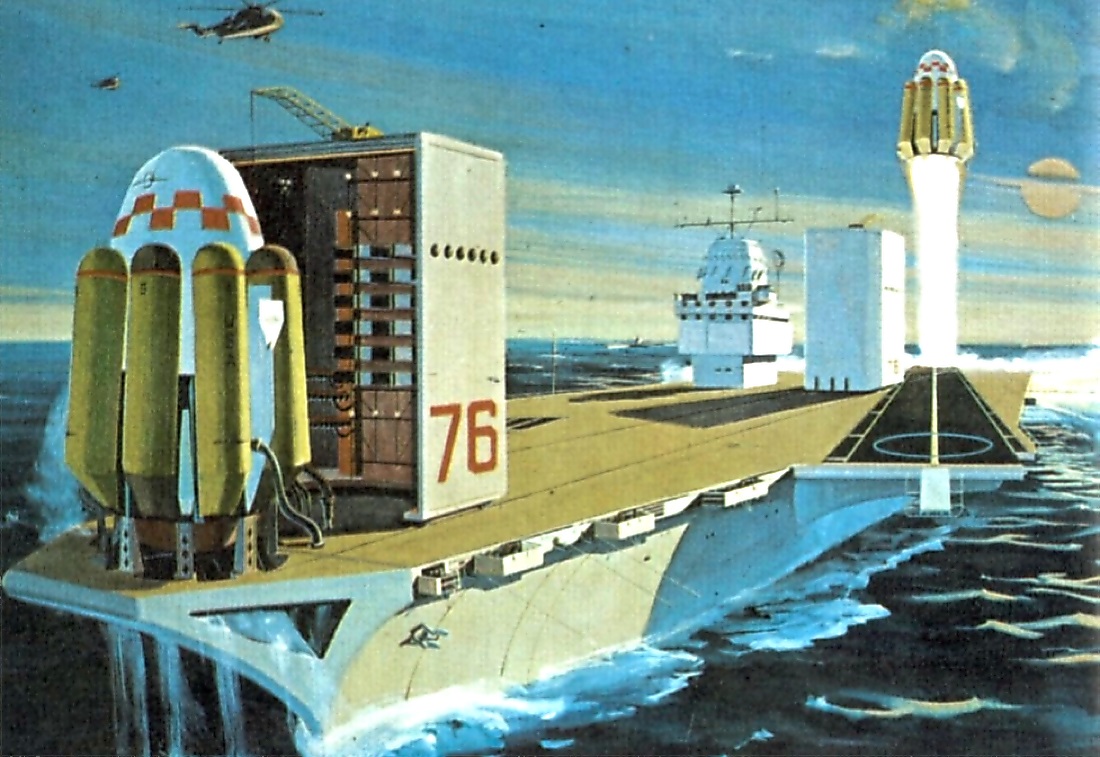
“▲ Ithacus T-100 Rockets Launching From an Enterprise-Class Nuclear Aircraft Carrier (Lowther, 1963).”
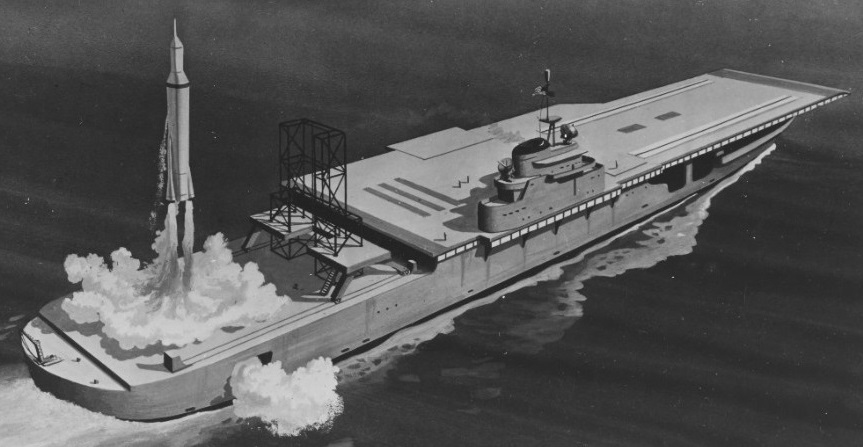
“▲ Satellite Launching Ship Concept Artwork (U.S. Navy, 1961).”
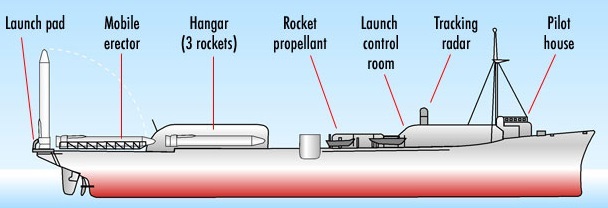
“▲ US Navy’s Bureau of Ships Sea-Based Launch Site Concept 1963 (Zac, 2006).”
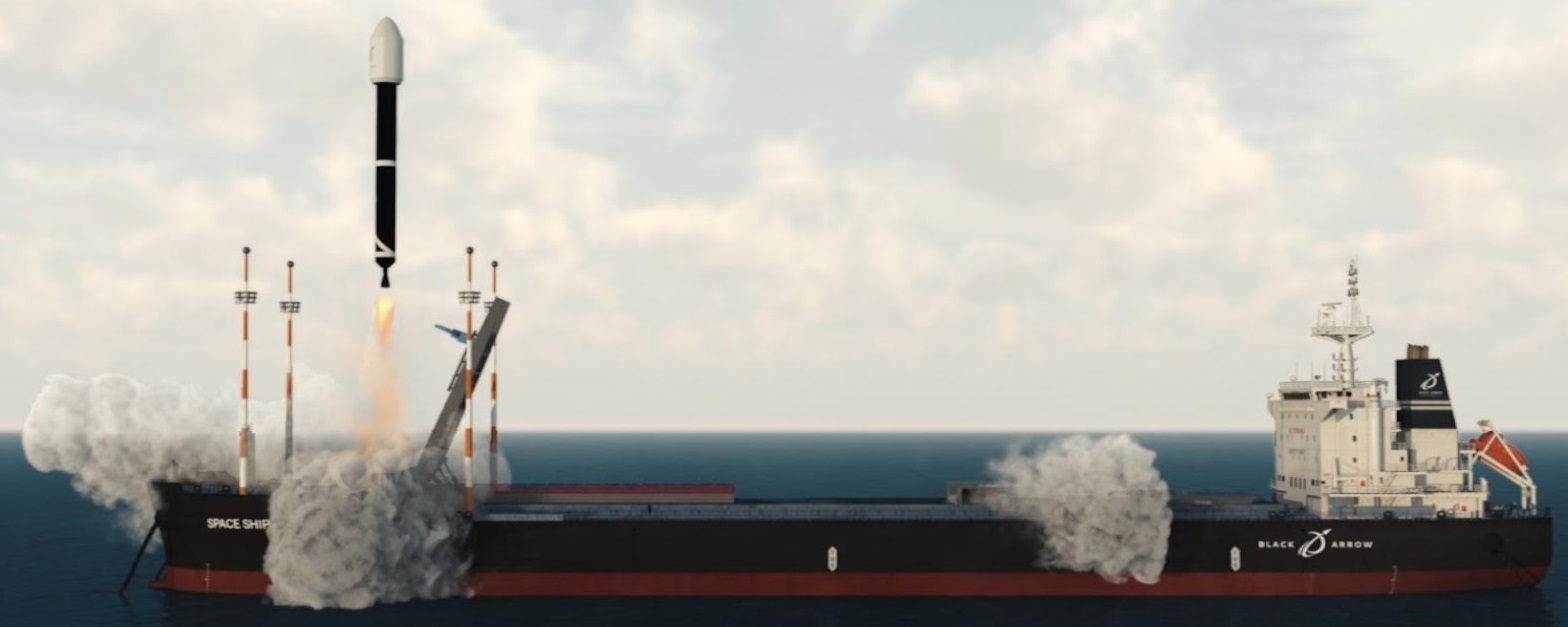
“▲ Concept ‘Space Ship’ (Black Arrow Space Technologies, 2021).”
This short exploratory paper will look at the notion that the Spacecraft Carrier will replace the Aircraft Carrier as the major capital ship in most fleets. The paper will also explore the notion that Space Forces will likely need to develop Sea-Based capabilities, in order to achieve Terrestrial Manoeuvre, that directly parallels the quest for Space Manoeuvre dominance. The military concept underpinning this technology is capturing global manoeuvre by sea, in its relationship to the next strategic frontier – the spherical field surrounding the Earth, containing Earth’s Satellite Layer, and the ability to Circumnavigate the Earth.
ORIGIN OF THE LAUNCH VESSEL OR SHIP
The 1947 U.S. experimentation with firing a captured German V2 Rocket from the Flight Deck of the Aircraft Carrier USS Midway was largely intended to test, “shipboard launching of large bombardment rockets of the V2-type” (United States Navy, 1947). The experiment also tested the viability of an, “attempt to launch a liquid fuelled rocket from an Aircraft Carrier.” (Turner, 2007) Intended at the time, as the progenitor in the design of guided missile ships, the 1947 experiment also needs to be read-against an earlier notion, from 1945 (Clarke, 1945; 1945). It was proposed launching into Geostationary Orbit, and giving a satellite the ability to Circumnavigate the Earth, using a captured German V2 Rocket by changing its trajectory. The original justification for using the USS Midway was its suitability, having a steel deck that could withstand the heat from the rocket engine’ flame, its elevator capacity to lift a rocket up from the Hangar Deck, its fire-fighting facilities, and its steadiness at sea (United States Navy, 1947). Interestingly, the site chosen on the Flight Deck was its rear or aft-end near the rear Inboard Hangar Deck Elevator. This design choice has proved to be a lasting feature seen on all later Launch Vessels and Ships.
The 1961 U.S. Navy concept to use a modified Essex or Ticonderoga Class Aircraft Carrier to launch an Atlas-type rocket, was seen as offering the ability, “launching Space satellites into orbits not readily accessible from launch sites in the United States.” (U.S. Navy, 1961) A more expanded conception of the strategic import, was given in 1963:
“the main rationale for building a Space launching ship was its ability to be deployed in the Equatorial Regions of the Earth, where access to the Geostationary Orbit would be more energy efficient and cheaper compared to missions originating from Cape Canaveral.” (Crossley, 1963; Zac, 2006)
From a commercial perspective, a somewhat similar strategic justification is found for developing Launch Vessels or Ships, as one of the major impediments to the exploitation of Space, has been identified as:
“our land launch facilities are costly, inadequate and congested. Schedule delays on one launch cause delays for all succeeding launches from a given launch pad.” (Draim, 1993)
The Chinese rationale, for developing Launch Vessels or Ships, follows a similar set of strategic justifications:
“Sea launches offer advantages such as the ability to position closer to the Equator, requiring less fuel to reach orbit and thereby lowering overall launch costs. It also reduces the possibility of damage on the ground from falling rocket debris.” (Associate Press, 2019)
A similar driver in the case of the Sea Launch Joint Venture, to develop a Launch Vessel, was identified:
“In addition to maximizing the payload of the rocket by flying from Equatorial Regions, movable launch facility would offer great flexibility for potential customers to reach any conceivable orbit, while always flying over remote regions of the ocean.” (Zac, 2006)
A similar concern for safety, underpins the use of Launch Vessels and Ships,
“one benefit of launching rockets at sea: if something goes wrong at low altitude, there are no damaged buildings, utilities, roads, trucks, and cars, as opposed to certain Land-Based launch failures that have caused considerable harm to the surrounding area” (Turner, 2007).
CHARACTERISTICS OF LAUNCH VESSELS AND SHIPS
The 1963 U.S. Navy’s Bureau of Ships study into developing a Launch Vessel or Ship proposed a 17,700 ton vessel, some 565 feet: 172 meters long capable of carrying up to three rocket launchers (Crossley, 1963; Zac, 2006). The launching tower was erected on the edge of the ship’s stern, with the rockets lifting-off vertically, carrying a satellite to a Geostationary Orbit. Overhanging the rocket launching hole and rig from the edge of the ship’s stern largely gave an escape for the rocket engine flame to be absorbed at the sea surface. The same design choice is depicted on the concept for using a modified Enterprise-Class Nuclear Aircraft Carrier, to launch a pair of Ithacus T-100 Rockets. Launching holes project from the stern and bow ends of the Carrier’s Top Deck (Lowther, 1963).
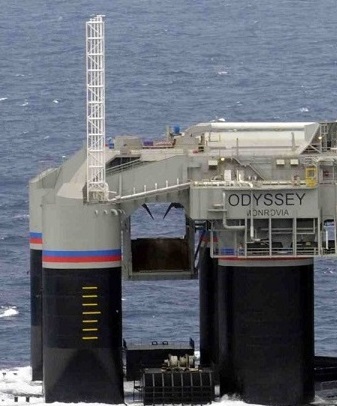
“▲ The LP Odyssey’s Flame Deflection Structure (Sea Launch, 2016).”
The 1961 U.S. Navy concept for a Launch Ship modified the hull of an Essex or Ticonderoga Class Aircraft Carrier and had the rocket launching from a pit-pad set into the rear third of the hull. The corresponding portion of the Flight Deck was removed. The rocket engine flame was deposited into an under-the-platform flame deflection structure that ported-out on either side of the ship, above the waterline. A similar structure can be seen on the LP Odyssey, a converted Semisubmersible Oil Rig Platform, that appears as a massive duct under the platform-deck (appearing in the LP Odyssey photograph). The ‘Space Ship’ (Black Arrow Space Technologies, 2021), has a similar design as the 1961 concept. The ‘Space Ship’ is a Combined Command, Control, Assembly and Launch Ship. The ship’s combined functions has necessitated it placing the pit-pad and duct at the vessel’s bow.
The ‘Space Ship’ Control area is located at the far opposite stern, placing it at a safe distance from the Launching area. It may be, one approach to managing the considerable downwards force of the rocket launch at the bow end, is to use the ship’s ballasting system to redistribute weight within, allowing its trim to align along the rest of its length, and at the stern area, to counteract the force.
Russian research from the 1980s identified that a problem design arose with Launch Vessels and Ships,
“[that had]… considerably smaller floating platform and the launch pad placed at its stern, instead of in a central location. Such a layout generated concern about distribution of loads across the platform” (Kozhukhov, 1998; Zac, 2006).
Nevertheless, stern or bow, rear or forward section of a Launch Vessel or Ship placement of a launching hole, or pit-pad seems to have predominated in the designs that arose from 1961. It was also the V2 Rocket launching placement choice made on the USS Midway. In all cases as a general rule, a vessel used as a rocket launching pad will be sensitive to load changes, and will therefore need its onboard mass trimmed to maintain stability, which is achieved through ballasting adjustments. In the case of Drone Ship Landing Pads, used by SpaceX, the orientation of the vessel is largely defined by wave and wind direction, and not by the rocket’s potential trajectory. The vessel’s stability in terms of it rocking due to wave action is potentially reduced by having its short-side (bow or stern) facing oncoming waves. The Drone Ship, as it is a relatively flat barge-type of craft has the added advantage of being able to stabilize by taking-on sea water as ballast and thereby lowering the vessel in the water. The vessel also has powerful thrusters located in each corner to maintain its position. In the case of a Semisubmersible Platform Vessel its good motion characteristics is achieved by its pontoons (where the main part of its buoyancy is located) underneath the surface. The supporting columns crossing the water surface have relatively small areas. The vessel does not respond to wave action giving overall platform stability. Whereas in the case of an Aircraft Carrier, its stability has traditionally relied on a deeper hull, with the centre of gravity shifted lower in terms of the vessel’s overall weight, which is why the 1947 experiment on the USS Midway, 1961, and 1963 concepts all used Aircraft Carriers.
EMERGENCE OF THE LAUNCH VESSEL OR SHIP
The Soviet-Era Moscow-based KBTM Design Bureau, in the 1960s, propose Sea-Based automated launch procedures and compact pad that could be used onboard a cargo ship (Zac, 2006). The technical problem, was the available rockets at the time did not have the lifting capacity needed to get larger Geostationary satellites, which would be the primary cargo for Sea-Based rockets, into Space. By 1975, Soviet rocket designs had greater lift, and state-of-the-art launch systems, and interest in Sea-Based launching began to be explored again, which largely continued throughout the 1980s (Kozhukhov, 1998; Zac, 2006). Around 1991, with the disintegration of the Soviet Union, and potential loss of Kazakhstan Land-Base Launching Facilities, the famed Baikonur Cosmodrome that had been its main Space Port, Russian design concepts using various large vessels of the nation’s civilian fleet for Sea-Based Space rocket launching pads emerged (Zac, 2006). Interestingly in the early 1990s, one of the disputes within the Sea Launch Joint Venture was over Russian and Norwegian partners voting for a converted Oil Rig Platform option, while the Boeing partner argued for a supertanker (Zac, 2006). The final decision by the Sea Launch Joint Venture created a firm distinction between three types of Sea-Based Rocket Launch Vessel: (1) The Launch Vessel; (2) Command, Control and Assembly Ship; and, (3) Combined Command, Control, Assembly and Launch Ship.
TWO VESSELS APPROACH
The Sea Launch Joint Venture formed in 1995, saw introduction of the two vessels approach, with a Command, Control and Assembly Ship, called the ‘Sea Launch Commander’, and use of a modified Oil Industry Ocean Drilling Rig Platform. This was a deviation from the older Soviet-Era design for a single ship that undertook all the functions by the KBTM Design Bureau. Even though, in this early period, some alternative designs considered a floating semi-submerged platform, that largely resembled a large pontoon barge, combined with a separate Command Ship; a stationary Jackup Rig, which could still be moved and towed to a new location (based on the designs seen in the Oil Industry), that also combined all the functions; and, a larger dual-body ship that likewise combined all the functions. It is presumed, SpaceX in relation to its Deimos and Phobos Starship Offshore Platforms will also use a separate Command, Control and Assembly Ship. The use of a Command Ship and Launch Vessel flotilla, has developed into a functionally divided system. Rocket assembly, command and control functions on one ship, that carries the rocket to the other vessel that has the launching platform. The rocket is transferred horizontally from the Command Ship to the Launch Vessel into its Hangar located under the platform-deck. Personnel on the Launch Vessel then evacuate to the Command Ship, and it moves to a safe distance. On the Launch Vessel the rocket is lifted remotely to the launch pad, erected into its vertical firing position. Automated systems fuel the rocket, conduct its final checks, and maintain necessary climate control till it is launched.
A unique variation on the two vessel system is the Russian Priboi. The rocket is ejected from its Command, Control and Assembly Ship, into open water:
“The surface vessel has a docking chamber which is used to assemble the launch vehicle and to evacuate it on the water surface by means of a floating anchor. Hermetically sealed areas under fairing and in launch tray provide positive floatage of the launch vehicle in the horizontal position. After the transfer of the launch vehicle from the horizontal position into free-sailing state in the vertical position the launch tray is separated and the first stage engine is initiated. The launch command is initiated from the vessel.” (Makeev State Rocket Centre; Zac, 2006)
In the United States, a similar technology direction was taken with the development of Floating Rocket Launches, from the 1960s, and with the 1984 launch of the Dolphin Vehicle, which was launched from a floating launch cannister at sea (Turner, 2007). The more famous example of a Floating Launch, which would have also required a Nuclear Aircraft Carrier to tow it out to sea to be launched, was the gigantic 1962 Sea Dragon (Grossman, 2017). This massive rocket concept floated horizontally, till its ballast tank-cap filled with water, sinking it to the vertical with its second stage above the waterline, and was then launched.
THE NEW SPACECRAFT CARRIERS
The history of the Sea-Based Space Rocket Launch Vessel have seen a number of different design trajectories. Some central features endure, and either all contained on a relatively large ship like an Aircraft Carrier, or large Cargo Ship – making a Combined Command, Control, Assembly and Launch Ship, or have opted to separate the functions by utilising a flotilla consisting of Command Ship and Launch Vessel. The latter largely been driven by the requirement to launch ever larger rockets. The most recent example has been SpaceX announcement it will use its Oil Rig conversions, the Deimos and Phobos Starship Offshore Platforms for Starship launches. Currently planned to use a class of Launch Vessels based on converting Second-Hand Semisubmersible Oil Rigs, that are in some respects smaller than the original LP Odyssey[1]. However, this does not exclude the possible build of much larger Semisubmersible Platforms based on some of the Oil Industry giants that have been recently commissioned, such as the Ocean Great White, that weighs-in at 60,800 tonnes (Diamond Offshore). Potentially creating a generation of Super Heavy Sea Launch Carriers, the ‘Jupiter & Saturn’ Class that could be used as Launch Vessels for still larger Super Heavy Lift Rockets, that will launch Humanity as an Interplanetary Species.
It is open to question, if the current evolution of Space Forces (that have largely descended from Air and Rocket Forces), may continue to evolve into Sea-Based Forces. It could be envisaged, that a future Space Force will ultimately acquire a next generation of Spacecraft Carrier forces, based on: (1) Mobile Semisubmersible Platform Vessels needed to launch a Super Heavy-Lift Rocket, along with its attendant flotilla; and (2) Smaller Command, Control, Assembly and Launch Ships, envisaged to launch smaller payload rockets will also likely come into general use.
The strategic raison d’etre for the Sea-Based launching of an Intercontinental Ballistic Missile, has been that,
“[it]… puts your opponent on the defensive, a priori. He is forced to react to your choice of operating areas, and to your tactical manoeuvres.” (Draim, 1980)
The same reasoning for Sea-Based launching Intercontinental Ballistic Missile, finds its parallel in the strategic thinking for developing Launch Vessels or Ships, to get a satellite into Earth Orbit, or Suborbital. Strategically, Launch Vessels or Ships have geographical manoeuvre; however, in some respects the system is still tied to a traditional Land-Based geography. Monitoring of orbital launches are either controlled from a Military Centre or a Civil Mission Control Centre, and the launchings are tied to ground tracking stations, on national, allied or international partner’s territory to monitor an orbital mission in the case of the upper rocket stage. This outstanding limitation, may see ultimately the transfer of much of the tracking and control functions into Space, or onto the surface of the Moon, as strategic insurance against making Ground-Control systems first-strike targets in a war.
The Russian announcement to renew the LP Odyssey made by the Deputy Prime Minister Yuri Borisov on the sidelines of the Army-2020 Forum (TASS, 2020), was not linked to any military purpose. It is nevertheless likely to be in any countries’ national-strategic interests to have Launch Vessels and Ships capability. Much the same reasoning has been posited by Chinese research in regards to the strategic value of Launch Vessels and Ships,
“This breakthrough in sea launch technology will enable China to launch medium and large satellites and constellations ‘both on land and sea’, especially into low-inclination Low Earth Orbits … and it allows China to remain competitive in the fast-paced Space Industry.” (Song, 2020)
Increasing dependence by countries on their Space-Based Infrastructure, will likely see a greater military need to use Launch Vessels and Ships to get satellites and equipment into Space as quickly as possible. Vulnerability of Land-Based facilities to attack, will by necessity lead to commissioning new types of Spacecraft Carriers. In effect becoming a new type of strategic force capability. Use of more than one Launch Vessel or Ship, by any country, will likely be necessary more for strategic redundancy. Such as for use receiving re-landing rockets, in order to achieve greater turn-around, ensuring continuing operation, if one of the Carriers is destroyed by any attack or launch accident.
ORBITAL SPACEPLANE SPACECRAFT CARRIER
The need to operate in Space, protect Space-Based Infrastructure, and attack enemy systems can envisage a novel type of Spacecraft Carrier designed for launching and recovering an Orbital Spaceplane, along with other conventional aircraft in support. This speculation is based on possible technology convergence of two current technologies. Developments in increasingly shorter – more compact, with more efficient powerful engines, on returnable first-stage booster rockets, that can launch a vehicle into Low Earth Orbit, or Suborbital. Mated with developments in single, and small crewed, or robotic Orbital Spaceplanes, similar to contemporary craft like the Dream Chaser and Boeing X-37 (and the Russian and Chinese versions now known to exist). The Spacecraft Carrier could be envisaged with a runway deck designed to recover incoming Orbital Spaceplane, along with launch and landing pads for returning rocket boosters, cranes, and movable launch towers (not unlike some of the 1963 concept designs). Major technical challenges may be how to massively shorten run-way requirements for a returning Orbital Spaceplane. For instance, the civil Dream Chaser can land at any suitable runway that is 8,000 feet: 2,400 meters long, around the world without requiring specialized equipment (Taylor, 2014). A current in-service Super Aircraft Carrier has a massively shorter runway deck, that is generally under 1,092 feet: 332.85 meters in available length. Technical solutions could include using a tailhook snagging an arresting wire, or a returning Orbital Spaceplane may slow its speed on landing like the Space Shuttle Orbiter famously used its drag parachute for that purpose (NASA, 2006).
CONCLUSION
It is anticipated, design iterations of the Spacecraft Carriers overtime will develop into several types: Command, Control and Assembly Ship, and Launch Vessel flotilla; or the smaller Combined Command, Control, Assembly and Launch Ship. The strategic shift globally occurring, is several countries developing and acquiring the capability for Sea-Based Rocket Launch Facilities. What will follow, will be an identical shift (as occurred in the Oil Industry since the 1960s) towards launching even bigger and more expensive vessels specifically built by shipyards adapted exclusively for Super Heavy Lift Rocket Launching offshore, alongside more mobile Launch Ships for smaller payloads. Increasing the operation of the Orbital Spaceplane is a potential to consider. The notion of an Orbital Spaceplane Spacecraft Carrier is pure speculation. The 1963 concept envisaged an Enterprise-Class Nuclear Carrier, to launch a pair of Ithacus T-100 Rockets (Lowther, 1963). The craft were intended for a next-generation concept Earth-to-Earth Rocket Transporter (Weintz, 2015). The Carrier was intended to multiple launch the Ithacus delivering a strategic force to anywhere on the Planet within an hour. While, the 1963 concept Carrier seems implausible, the recent resurgence of interest in Earth-to-Earth Rocket Transporters, based on the development of experimental rocket craft like the SpaceX Starship designed to convey around 100 tons of cargo, or up to 100 Human passengers, and recent pronouncements that rocket transportation will drastically shorten global transport times, has raised the level of interest in how these types of transport systems would work, and might work in a military context (Roza, 2021; Secretary of the Air Force Public Affairs, 2021). The expressed national-strategic goal will be to give greater geostrategic flexibility in terms of moving and positioning for best advantage, in particular moving to launch Space rockets along the Earth’s Equatorial Region, or wherever on the Earth’s surface – as 71% of the planet is covered by the seas. This will shift dramatically the geopolitical control of Space, as countries will no longer be fixed to specific Land-Based facilities. The need to achieve strategic lift capacity may well see a return to large Launch Vessels and Ships being used to launch and land Earth-to-Earth Rocket Transporters, as the new airport facilities for large-scale build-up of forces. The scenario becomes more likely given that most military operations in the future will be conducted in the mega coastal cities, that will increasingly concentrate the vast bulk of the world’s urban population. In the era of sea-level rise the need to get forces and aid into these sea-level settlements will likely become a key future strategic driver. This may not be the only design trajectory, as current pace of Spacecraft development will likely see the notion of a Space-Based Spacecraft Carrier become a reality.
- REFERENCES
- • Associate Press. 2019 China Launches Rocket from Yellow Sea Platform for First Time. The Guardian (6 June).
• Bergin, C. 2018 Blue Origin Publishes New Glenn Overview as Pad and Landing Ship Continue Development. NASA Space Flight Website (28 November).
• Black Arrow Space Technologies. 2021 Concept ‘Space Ship’. Fact Sheet.
• Clarke, A.C. 1945 V2 for Ionosphere Research? Wireless World (February).
• Clarke, A.C. 1945 [-1968] The Space-Station: Its Radio Applications. Spaceflight. Volume 10. Number 3 (March).
• Clark, S. 2006 Russian Submarine Launches Russian Microsatellite. Space Website (30 May).
• Crossley, R.P. (Editor) 1963 Seagoing Pad to Launch Satellites [Navy Designs Seagoing Pad to Launch Satellites at Sea]. Popular Science. Volume 182. Number 5 (May).
• Diamond Offshore. Ocean Great White. Fact Sheet.
• Draim, J.E. 1993 Sea-Launch for Small Satellites: An American/Russian Joint Venture. Sea-Launch Investors, Inc. Fairfax. Virginia.
• Draim, J.E. 1980 Sea-Based Deployment of Floating-Launch Missiles: Near Term and Far Term Design Concepts for Sea-Based Surface Mobile MX Missile Deployment. A Study For The Office of Technology Assessment United States Congress. Hydra Corp (15 December).
• Grossman, D. 2017 The Enormous Sea-Launched Rocket That Never Flew. Popular Mechanics (3 April).
• Kozhukhov, N.S. 1998 Kompleksy Nazemnogo Oborudovaniya Raketnoi Tekhniki, 1948-1998 [Missile Ground Equipment Complexes, 1948-1998]. Moscow.
• Lowther, S. 1963 Ithacus T-100 Rockets Launching from an Enterprise-Class Nuclear Carrier. Douglas Aircraft. Illustration.
• Makeev State Rocket Centre. Priboi Launch Vehicle. Fact Sheet.
• NASA. 2006 Landing the Space Shuttle Orbiter. NASA Facts.
• Roza, D. 2021 The Air Force Wants $48 Million to Drop Commandos into Battle from Orbit. Task & Purpose (2 June).
• Sea Launch. LP Odyssey. Fact Sheet.
• Sea Launch. 2016 Photograph of the LP Odyssey.
• Secretary of the Air Force Public Affairs. 2021 Department of the Air Force Announces Fourth Vanguard Program (4 June).
• SpaceX. Deimos and Phobos Starship Offshore Platforms. Fact Sheet.
• Song, Z. Xie, Z. Qiu, L. Xiang, D. Li, J. 2020 Prospects of Sea Launches for Chinese Cryogenic Liquid-Fuelled Medium-Lift Launch Vehicles. Chinese Journal of Aeronautics.
• Taylor, F.W. Allison, C.J. Lee, C.L. 2014 Challenges and Opportunities Related to Landing the Dream Chaser Reusable Space Vehicle at a Public-Use Airport. Space Traffic Management Conference. Sierra Nevada Corporation.
• TASS [Russian News Agency]. 2020 Sea Launch to be Restored at Cost of About $470 Million. Space Watch Global Website.
• Turner, A.E. 2007 Ocean-Based Launch: Extending a Successful Approach to New Applications. The Space Review Website (12 February).
• U.S. [United States] Navy. 1961 Satellite Launching Essex or Ticonderoga Class Aircraft Carrier. Naval Photographic Center’s collections. Official Photograph (12 December). National Archives Photographic Reproduction System. Photo # 428-KN-2961.
• United States Navy. 1947 Operation Sandy. Summer 1947. U.S. Atlantic Fleet Task Group 41.16 Photographic Report MN6662 NPC 1947. San Diego Air and Space Museum Archives.
• Weintz, S. 2015 Space Marines With Jetpacks! War is Boring.
• Wired News Report. 1998 Russian Sub Launches Satellite. Wired (7 July).
• Zac, A. 2006 US Navy’s Bureau of Ships Sea-Based Launch Site Concept 1963. Russian Space Web.
AUTHOR
Chris Flaherty authored the Terrorism Research Center’s report – Dangerous Minds (2012). He was the co-primary author, along with Robert J. Bunker of the book – Body Cavity Bombers: The New Martyrs (iUniverse, 2013). Two essays of his, from 2003 and 2010 were reprinted in the Terrorism Research Center’s book – Fifth Dimensional Operations (iUniverse, 2014). He recently contributed a book chapter – The Role of CCTV in Terrorist TTPs, edited by Dave Dilegge, Robert J. Bunker, John P. Sullivan, and Alma Keshavarz, the book – Blood and Concrete: 21st Century Conflict in Urban Centers and Megacities, a Small Wars Journal anthology, published on behalf of the Small Wars Foundation with Xlibris (2019). Chris Flaherty is currently a Space & Defense Tech and Security News Regular Contributor.
CONTACT DETAILS: Dr Chris Flaherty https://au.linkedin.com/in/drchrisflaherty
[1] Launch Vessel Size and Oil Rig Conversions:
| NAMES | LENGTH | WIDTH (BEAM) | DISPLACEMENT | ||||
| Ocean Ranger II | LP Odyssey | 390 feet | 118.8 meters | 226 feet | 68.8 meters | Gross (Empty) | 30,000t |
| 436 feet | 132.9 meters | 220 feet | 67 meters | Submerged | 50,600t | ||
| MossCS50 | SBX-1 | 381 feet | 116 meters | Not Known | 50,000t | ||
| Ensco8500
Ensco8501 |
Deimos | 310 feet | 94.49 meters | 226 feet | 68.8 meters | Gross (Empty) | 19,377t |
| Phobos | Same | Same | Submerged | 27,877t | |||





